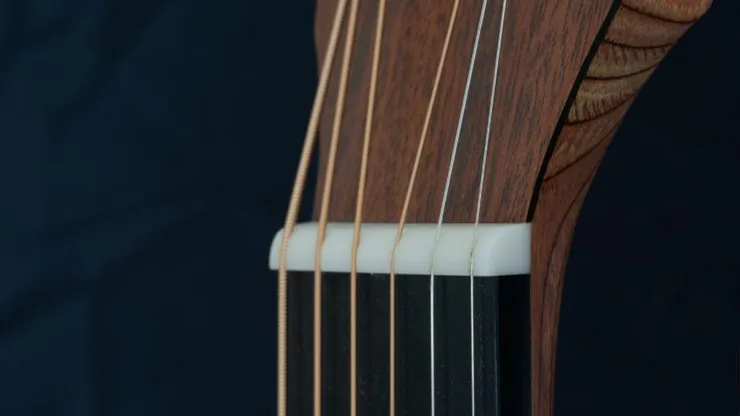Many factors come into play when it comes to the playability and sound of a guitar. One vital component that often goes unnoticed is the simple guitar nut. Located at the top of the guitar’s neck, the nut plays a crucial role in maintaining proper string height, spacing, and alignment. But what exactly IS a guitar nut, and why is it so important? Read on for the low-down on one of the silent heroes of guitar tone!
What Is a Guitar Nut and Why Is It Important?
The guitar nut, a small yet crucial component, is meticulously crafted from materials including bone, plastic, or graphite. Positioned at the junction of the headstock and the neck, its primary role is to anchor the strings securely while ensuring precise alignment and spacing. By establishing a point of contact between the vibrating string and the neck, the nut becomes a vital conduit that influences tone, sustain, and overall playability.
The nut’s design and construction contribute significantly to the nuanced character and versatility of the guitar. The choice of material, shape, and dimensions of the nut can affect the instrument’s resonance, harmonics, and string action. A well-crafted nut allows for smooth string bending, accurate intonation, and a comfortable playing experience. It’s through this seemingly small but essential component that each note and chord can ring with clarity and precision.
Exploring Different Guitar Nut Materials
When it comes to guitar nuts, the material choices are plentiful, each holding its own charm. Whether opting for a modern synthetic material or a more vintage offering, the material choice significantly impacts your guitar’s sound quality and performance. Here, we’ll examine the characteristics and benefits of some of the most popular guitar nut material choices.
Bone Nuts
Bone nuts have been a popular choice among guitarists for centuries. Their dense and resonant nature helps to transfer vibrations efficiently, resulting in improved sustain and tone. Additionally, bone nuts offer excellent durability and are customisable for a perfect fit. These natural properties make them highly sought after by musicians seeking the utmost quality in their instruments.
Moreover, while bone nuts typically require professional shaping and installation, this ensures the utmost precision and attention to detail. This meticulous process contributes to the overall craftsmanship and value of the instrument, making bone nuts a symbol of excellence in the guitar world.
While bone nuts may be slightly more expensive than some alternatives, the investment is well worth it for musicians who prioritise exceptional sound and long-lasting performance. With their rich history and unparalleled characteristics, bone nuts remain a cherished choice for guitarists who strive for the finest quality and craftsmanship in their instruments.
Plastic Nuts
Plastic nuts, often crafted from materials such as synthetic bone or TUSQ, are a popular substitute for bone nuts. Not only are they budget-friendly and user-friendly, but they also boast commendable tonal characteristics.
Plastic nuts do have a slight tendency to dampen vibrations when compared to bone nuts, but they still manage to offer admirable sustain and accuracy. However, it’s worth noting that they may wear down relatively faster over time, necessitating more frequent replacements to ensure optimal performance and longevity.
Graphite Nuts
Graphite nuts are a modern and innovative choice for guitarists seeking excellent stability and self-lubrication. These nuts effectively reduce friction on the strings, resulting in smooth tuning and minimal string binding. Not only do graphite nuts offer superior performance, but they also boast remarkable durability and consistent tone.
While they may not provide the same warmth as bone nuts, they are a favourite choice of guitarists who prioritise optimal tuning stability and effortless usage. With graphite nuts, you can elevate your playing experience to new heights, knowing that you have chosen a reliable and long-lasting solution for your guitar.
Brass Nuts
Brass nuts, a classical favourite among musicians, bring a distinct tonality and resonance to the table. Famous for their bright, clear, and well-defined tones, brass nuts are particularly suited for guitarists seeking to amplify the brilliance and clarity in their sound. They also function well across various musical genres, making them a versatile pick.
Not only do brass nuts provide excellent sustain and durability, but their unique aesthetic appeal adds a touch of vintage charm to any guitar. The solid brass construction also ensures that they can withstand heavy usage, reducing the need for frequent replacements. However, brass nuts might require professional installation to ensure perfect fit and optimal performance. With a brass nut, you essentially combine the best of both worlds - aesthetic appeal and remarkable functionality.
Nut Width
Nut width, a critical aspect in the realm of guitars, refers to the width of the guitar’s neck at the nut. It’s a crucial element that significantly impacts the guitar’s playability and the player’s comfort. Typically measured in inches or millimetres, the nut width varies across different guitar models. Standard measurements usually range between 1.68 inches (42.67mm) for most electric guitars and 1.72 inches (43.68mm) for acoustic guitars. However, variations exist to cater to different playing styles and preferences.
A wider nut width, for example, provides more space between the strings, which can be beneficial for fingerstyle players, while a narrower nut tends to be favoured by those who prefer a more compact feel. It’s essential to remember that the ‘right’ nut width is subjective and should ideally align with your playing style and comfort. Therefore, when choosing a guitar, you should carefully consider the nut width to ensure a smooth, comfortable, and enjoyable playing experience.
Installing and Maintaining a Guitar Nut
Proper installation and maintenance of a guitar nut are essential for optimal performance. Here are some key guidelines to follow:
Professional Installation
If you’re unfamiliar with guitar repairs, it’s advisable to entrust the task of installing a new nut to a skilled and experienced professional luthier. By doing so, you can ensure that the nut is perfectly aligned, spaced, and filed for optimal playability and performance. This meticulous attention to detail will enhance the overall sound and tone of your instrument and contribute to a smoother and more enjoyable playing experience.
String Slot Height
When setting up a guitar, it’s crucial to ensure that the nut slots are cut to a consistent height. This meticulous adjustment allows the strings to rest just above the first fret, facilitating comfortable playing and preventing unwanted buzzing or sharp notes.
Lubrication
By applying a small amount of graphite or a specialised nut lubricant, such as Teflon-based lubricants or bone dust, you can effectively reduce friction at the nut. This reduction in friction contributes to stable tuning and smooth string movement and helps prevent string binding and sticking. The result is improved playability, enhanced sustain, and a more enjoyable playing experience.
Regular Inspection
Over time, due to constant use and exposure, the nut may gradually wear down or develop small cracks. It’s important to inspect the nut regularly for any visible signs of damage, such as chips, dents, or deformities. By promptly addressing any issues that arise, you can ensure the continued optimal performance and longevity of the nut, thereby enhancing the overall efficiency and functionality of the system.
Find My Guitar
The guitar nut may seem like a small and insignificant component, but its impact on the playability and sound of your guitar is undoubtedly significant. Whether you choose bone, plastic, or graphite, ensuring a well-crafted and properly maintained nut will unlock the full potential of your guitar and elevate your playing experience.
Now that you’re well-versed in the importance of the guitar nut, why not apply your newfound knowledge to finding your dream guitar? Head over to our comprehensive Finder tool, where you can explore a vast array of guitars, each with its unique nuance and style. Whether you’re a beginner seeking your first instrument or a seasoned player looking for an upgrade, our tool will guide you through the process, ensuring you find a guitar that not only sounds great, but feels like it was made just for you. Unleash your musical potential with Find My Guitar today!

